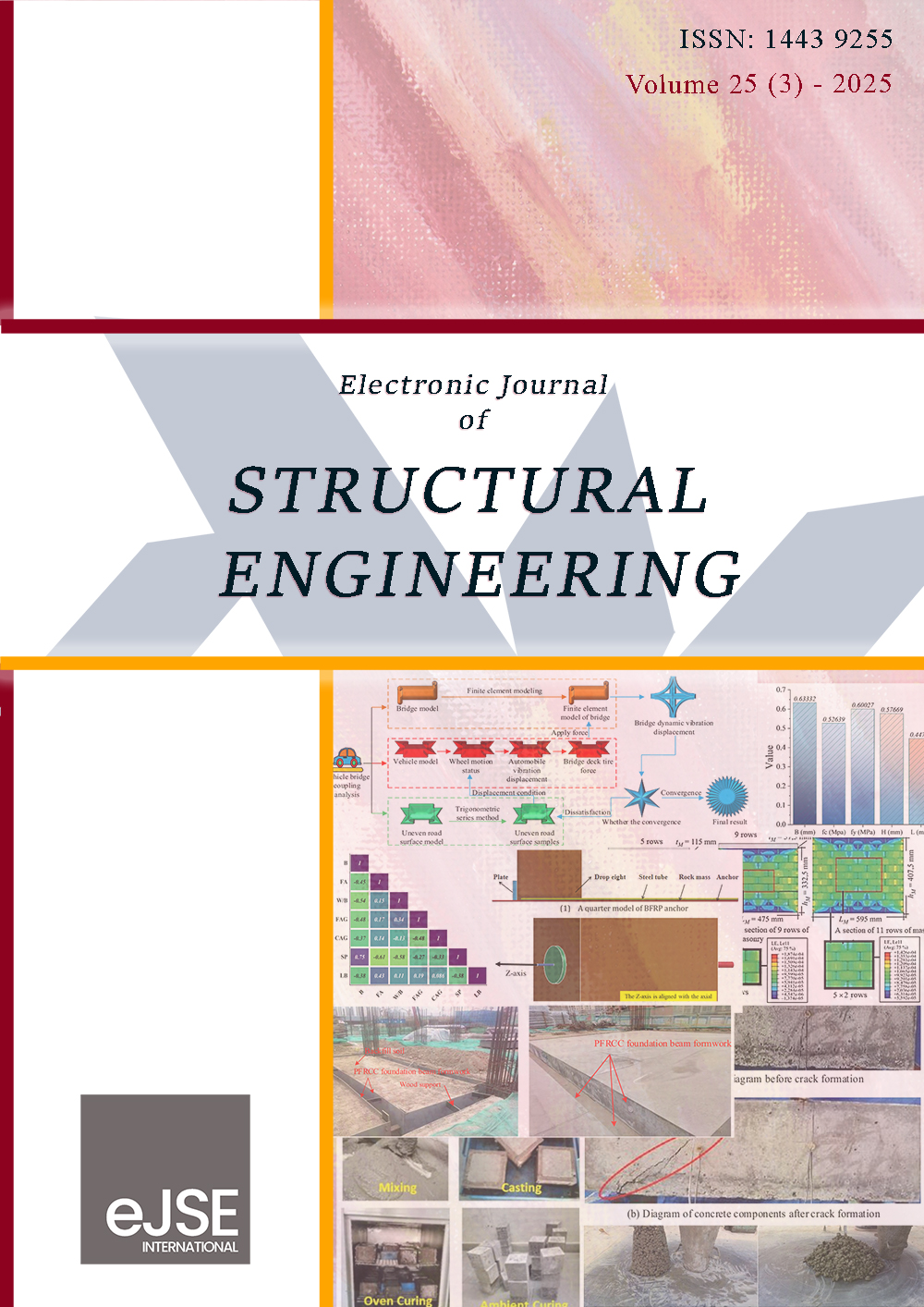Bridge Structural Damage Identification Technique Based on BPNN and Vehicle-bridge Interaction Analysis
DOI:
https://doi.org/10.56748/ejse.24774Keywords:
back propagation neural network, Axle coupling, Bridge structure, Damage identification, Axle displacement responseAbstract
During the use of bridges, the traditional method of detecting the bridge condition cannot be continuously monitored and maintained. To address this problem, the study proposed a damage identification method based on the interaction of back propagation neural network and vehicle-bridge interaction. The method analyzed the car response when the car passes over the bridge through back propagation neural network combined with coupled vibration of the vehicle-bridge, and carried out the inference of the response of the contact point of the car tire and the bridge. To create the damaged structural response model of the simulated bridge, the stiffness of the bridge contact point unit was then decreased. The response of the contact point of the bridge deck and tires was then used as the input of the back propagation neural network to compute the coupled vibration equations of the vehicle and bridge, and create the data set of the vehicle and bridge’s response. It can also locate the damaged bridge structure appropriately, and assess the extent of damage. The results demonstrated that the average accuracy of back propagation neural network in locating the damaged bridge structure was about 90%, the average accuracy of locating the damaged structure was kept at 85% under circumstances where varying noise levels are present. The maximum accuracy of assessing the degree of damage to the damaged structure was 98.54%, which is around 10% greater than the deep belief network and support vector machine’s performance in identifying the damage to the bridge structure. Taken together, the proposed bridge structure damage identification method can achieve high localization accuracy as well as quantitative accuracy.
Downloads
References
Chen, D., Cui, H., Li, Z., Xu, S., & Zhang, Y. (2024). Indirect identification and analysis of bridge damage using vehicle-bridge coupled vibration and deep learning. Journal of Performance of Constructed Facilities, 38(4), 4016-4028. DOI: https://doi.org/10.1061/JPCFEV.CFENG-4726
Chen, D., Zhang, Y., Wan, R., Li, Z., Xu, S., & Yang C. (2024). Indirect identification of bridge damage based on coupled vehicle-bridge vibration and 2D-CNN. Measurement Science and Technology, 35(5), 19-31. DOI: https://doi.org/10.1088/1361-6501/ad2ad5
Corbally, R., & Malekjafarian, A. (2021). Examining changes in bridge frequency due to damage using the contact-point response of a passing vehicle. Journal of Structural Integrity and Maintenance, 6(3), 148-158. DOI: https://doi.org/10.1080/24705314.2021.1906088
Hao, H., Wei, W., & Lei, H. (2020). Intelligent recognition of bridge damage based on convolutional neural network and recursive graph. Chinese Journal of Applied Sciences, 28(4), 966-980.
He, H., Zheng, J., Liao, L., & Chen, Y. (2021). Damage identification based on convolutional neural network and recurrence graph for beam bridge. Structural Health Monitoring, 20(4), 1392-1408. DOI: https://doi.org/10.1177/1475921720916928
Li, Z., Xiang, C., Qi, X., & Yang, H. (2023). Numerical analysis of continuous beam bridge damage identification based on vehicle response. Earthquake Engineering and Engineering Vibration, 43(2), 202-211.
Malekjafarian, A., Golpayegani, F., Moloney, C., & Clarke, S. (2019). A machine learning approach to bridge-damage detection using responses measured on a passing vehicle. Sensors, 19(18), 4035-4053. DOI: https://doi.org/10.3390/s19184035
Neves, A. C., González, I., Karoumi, R., & Leander, J. (2021). The influence of frequency content on the performance of artificial neural network–based damage detection systems tested on numerical and experimental bridge data. Structural Health Monitoring, 20(3), 1331-1347. DOI: https://doi.org/10.1177/1475921720924320
Nguyen, D. H., Bui, T. T., De Roeck, G., & Wahab, M. A. (2019). Damage detection in Ca-Non Bridge using transmissibility and artificial neural networks. Structural Engineering and Mechanics, 71(2), 175-183.
Nick, H., & Aziminejad, A. (2021). Vibration-based damage identification in steel girder bridges using artificial neural network under noisy conditions. Journal of Nondestructive Evaluation, 40(1), 15-43. DOI: https://doi.org/10.1007/s10921-020-00744-8
Sony, S., Gamage, S., Sadhu, A., & Samarabandu, J. (2022). Multiclass damage identification in a full-scale bridge using optimally tuned one-dimensional convolutional neural network. Journal of Computing in Civil Engineering, 36(2), 35-49. DOI: https://doi.org/10.1061/(ASCE)CP.1943-5487.0001003
Wu, R., & Zhang, C. (2023). Analysis of bridge vibration response for identification of bridge damage using BP neural network. Nonlinear Engineering, 12(1), 273-281. DOI: https://doi.org/10.1515/nleng-2022-0273
Xiang, C., Shi, H., & Yang, R. (2023). Research on bridge damage identification method based on modal frequency strain energy entropy and tent SSA BP neural network. Highway, 68(3), 143-150.
Xu, C., Yu, Q., & Yang, Q. (2020). Structural damage identification technology based on BP neural network. Applied Technology, 47(3), 63-68.
Yessoufou, F., & Zhu, J. (2023). Classification and regression-based convolutional neural network and long short-term memory configuration for bridge damage identification using long-term monitoring vibration data. Structural Health Monitoring, 22(6), 4027-4054. DOI: https://doi.org/10.1177/14759217231161811
Zhang, H., Zhong, Z., Duan, J., Yang, J., Zheng, Z., & Liu, G. (2022). Damage identification method for medium-and small-span bridges based on macro-strain data under vehicle-bridge coupling. Materials, 15(3), 1097-1113. DOI: https://doi.org/10.3390/ma15031097
Zhang, Y., Ma, C., & Chen, P. (2021). Bridge structural damage identification based on vehicle bridge coupling vibration. Highway Engineering, 46(2), 60-6470.
Zhao, L. (2024). Prediction of vibration response of simply supported beam bridge structure based on BP artificial neural network. Journal of Shenyang University of Technology, 46(3), 347-352.
Zhi, Z., Xue, L., & Cheng, W. (2023). Research on single damage identification of continuous beam bridges with equal cross-section based on vehicle bridge coupling. Journal of Hefei University of Technology: Natural Science Edition, 46(6), 813-821.
Zong, S., & Yi, C. (2020). Online speed and weight recognition based on cable force monitoring of cable-stayed bridges. Vibration and Shock, 39(17), 134-141.
Downloads
Published
How to Cite
Issue
Section
License
Copyright (c) 2025 Lingling Li, Yibo Zhang

This work is licensed under a Creative Commons Attribution 4.0 International License.







